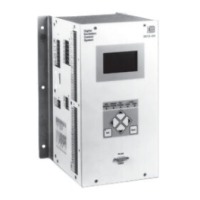3-8 Functional Description DECS-200
Generator Overvoltage
When the generator voltage increases above the Generator Overvoltage Level setting for the duration of
the Generator Overvoltage Delay setting, a generator overvoltage condition is annunciated. A generator
overvoltage condition is annunciated on the front panel metering screen and may be assigned to a
programmable output relay for external annunciation. The Generator Overvoltage Level setting is
adjustable from 0 to 30,000 Vac in 1 Vac increments. The Generator Overvoltage Delay setting is
adjustable from 0.1 to 60.0 seconds in 0.1 second increments. If the generator voltage drops below the
Generator Overvoltage Level setting while the delay timer is timing down, the delay timer is reset.
Generator overvoltage protection may be disabled without changing the level or time delay settings.
Loss of Sensing
A loss of sensing voltage is annunciated when either of two conditions exist:
• All three phases of generator voltage decrease below the Loss of Sensing Voltage–Balanced Level
setting for the duration of the Loss of Sensing Voltage Time Delay setting.
• Any individual phase of generator sensing voltage differs by more than the Loss of Sensing Voltage–
Unbalanced Level setting for the duration of the Loss of Sensing Voltage Time Delay setting.
A loss of sensing voltage is annunciated on the front panel Metering screen and may be assigned to a
programmable output relay for external annunciation. The Balanced and Unbalanced Level settings are
adjustable from 0 to 100% in 0.1% increments. The Time Delay setting is adjustable from 0 to 30.0
seconds in 0.1 second increments.
Below 10 Hertz
When the generator frequency decreases below 10 hertz, the condition is annunciated on the front panel
display as SYSTEM BELOW 10 Hz. The programmable output relays may be configured to initiate
additional annunciations or actions. A system below 10 hertz annunciation is reset automatically when the
generator frequency increases above 10 hertz.
Loss of Field
When the reactive power absorbed by the generator exceeds the Loss of Field Level setting for the
duration of the Loss of Field Delay setting, a loss of field condition is annunciated. A loss of field is
annunciated on the front panel metering screen and may be assigned to a programmable output relay for
external annunciation. The Loss of Field Level setting is adjustable from 0 to 3,000 Mvar in 1 kvar
increments. The Loss of Field Delay setting is adjustable from 0 to 9.9 seconds in 0.1 second increments.
If the absorbed reactive power decreases below the Loss of Field Level setting while the delay timer is
timing down, the delay timer is reset. Loss of field protection can be disabled without changing the level or
time delay settings.
Exciter Diode Monitor (EDM)
The DECS-200 monitors the output of the brushless exciter power semiconductors through the exciter
field current and protects against both open and shorted diodes in the exciter bridge. When implementing
the EDM, it is imperative that the user know and specify the number of poles for the exciter armature and
the number of poles for the generator rotor.
The EDM function estimates the fundamental harmonic of the exciter field current using discrete Fourier
transforms (DFTs). The harmonic, expressed as a percentage of the field current, is then compared to the
trip levels for open diode detection (OD ripple) and shorted diode detection (SD ripple). If the percentage
of field current exceeds the OD Level or SD Level setting, then the appropriate delay will begin. After the
programmable delay for the OD or SD event expires, and if the percentage of field current still exceeds
the OD Level or SD Level setting, the event is annunciated. An exciter diode failure is annunciated on the
front panel HMI and can be assigned to a programmable output relay for external annunciation. EDM
NOTE
If the number of poles for the exciter armature and the generator rotor is
unknown, the EDM function will still operate. However, only a shorted diode can
be detected. If the number of poles is not known, it is best to select all
parameters for the exciter open diode to off. In this situation, the generator and
exciter pole parameters must be set at zero to prevent false tripping.

